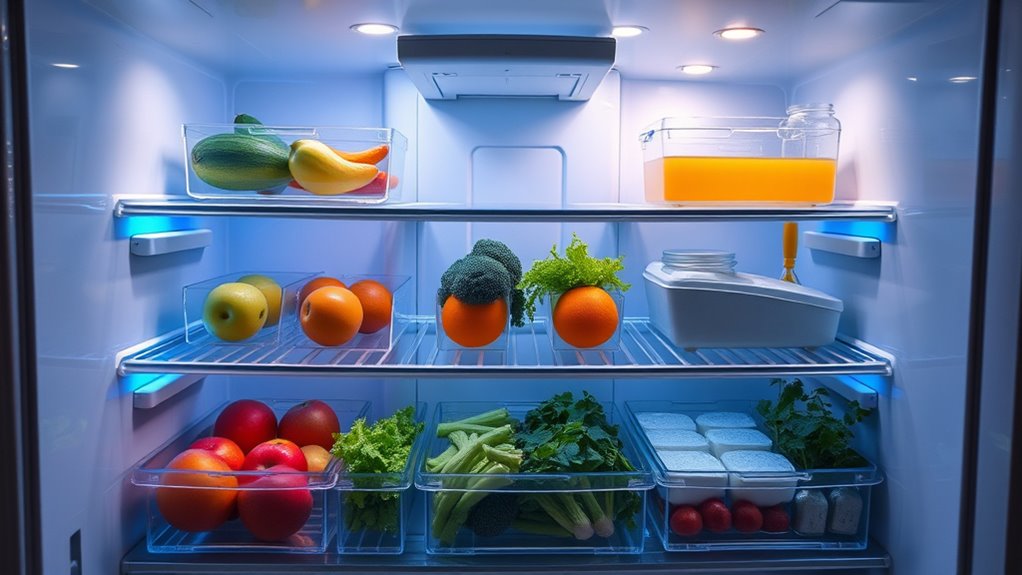Knowing your fridge’s temperature zones helps keep food fresh and safe. The top shelf is best for leftovers and drinks, while dairy belongs on the middle shelves. Fruits and vegetables go in crisper drawers, with raw meats stored on the bottom to prevent leaks. Door compartments are ideal for condiments and beverages. Temperature fluctuations can spoil food faster, so proper organization is key. To discover how to optimize your fridge’s performance, keep exploring these essential tips.
Key Takeaways
- Properly organize foods in fridge zones to maximize freshness, safety, and prevent cross-contamination.
- Top shelves are best for ready-to-eat foods, while bottom shelves store raw meats safely.
- Crisper drawers maintain humidity levels for fruits and vegetables, extending their shelf life.
- Door compartments are suitable for condiments and beverages, but less ideal for perishable items.
- Monitoring temperature zones prevents spoilage, bacteria growth, and ensures efficient fridge operation.
Understanding Your Fridge’s Design and Temperature Zones
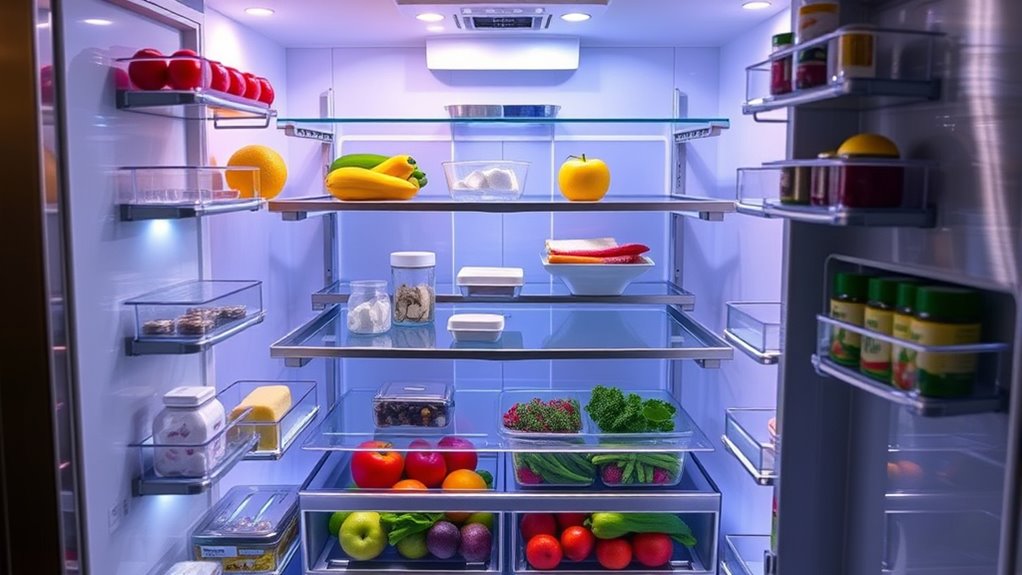
Your fridge isn’t just a single cold space; it’s designed with specific zones that maintain different temperatures to keep your food fresh and safe. Understanding these zones helps you optimize energy efficiency and reduce waste. The fridge’s temperature zones are strategically placed to balance cooling needs, with the main compartment typically set between 37-40°F. Properly managing these zones also simplifies cleaning routines, as you’ll know exactly where to focus your efforts. Regularly checking and adjusting the temperature in each zone prevents frost buildup and ensures consistent cooling. Keeping the fridge organized allows air to circulate properly, improving efficiency and preventing bacteria growth. When you understand your fridge’s design, you maximize its performance, conserve energy, and keep your food fresher longer. Proper organization within your fridge can also help maintain ideal temperature zones and improve overall efficiency.
The Top Shelf: Best Uses and Temperature Insights

The top shelf of your fridge is ideal for storing items that require a consistent, cool environment, such as ready-to-eat foods, leftovers, and beverages. Proper shelf organization helps maintain ideal temperature regulation, preventing spoilage. Keep perishable items like cooked dishes and snacks here to ensure they stay fresh longer. This shelf typically maintains a slightly higher temperature than lower zones, so avoid storing raw meats or dairy. To maximize space, group similar items and use clear containers for easy access. Remember, good shelf organization minimizes temperature fluctuations, keeping your food safer. Use the top shelf wisely to maximize freshness and reduce waste. Additionally, maintaining consistent temperatures across projector image quality zones can help preserve the integrity of your stored foods. By understanding the temperature insights of this zone, you make your fridge more efficient and your food safer.
The Middle Shelves: Optimal Storage for Dairy and Leftovers
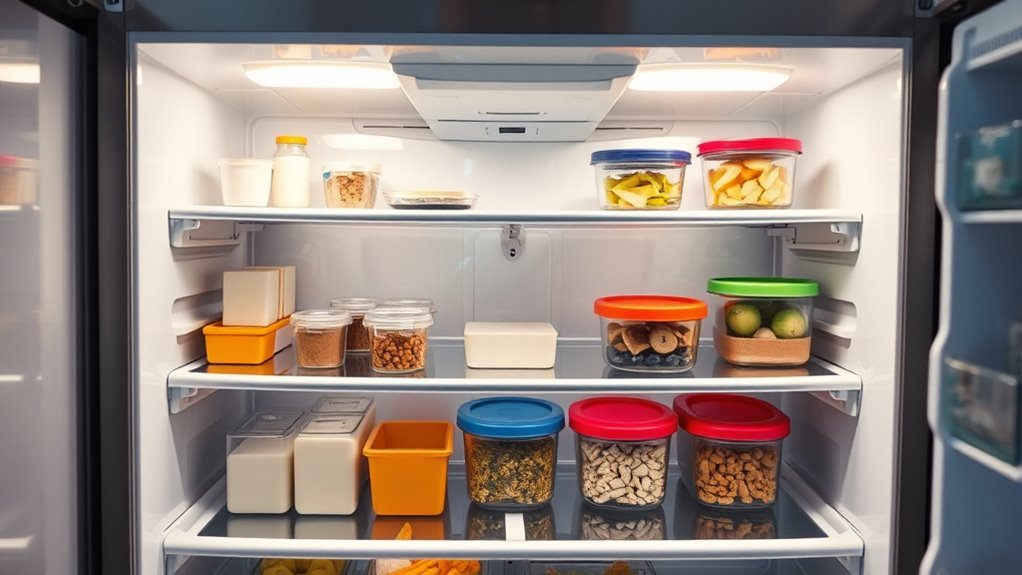
Middle shelves are the ideal spot for storing dairy products and leftovers because they typically maintain a consistent temperature that helps keep these items fresh longer. Keeping dairy fresh depends on stable, cool conditions, which the middle shelves provide. Plus, leftovers storage benefits from this even temperature, reducing spoilage risk. When you place dairy like milk, cheese, or yogurt here, you’re optimizing dairy freshness. Similarly, leftovers stored on these shelves stay safer and taste better over time. Avoid placing these items on the door or top shelf, where temperature fluctuations are common. Instead, utilize the middle shelves for reliable, consistent cooling. This simple adjustment can extend the life of your dairy and leftovers, ensuring they stay fresh and safe to eat longer. Additionally, angel numbers can serve as subtle signs of harmony and positive energy in your relationships, guiding you towards love and connection.
The Crisper Drawers: Managing Fruits and Vegetables
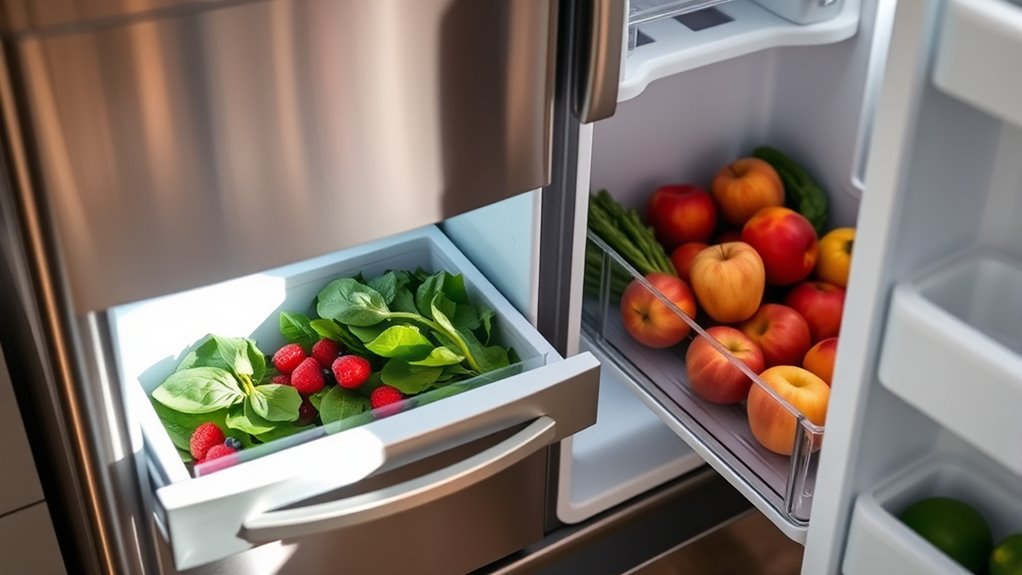
Your crisper drawers are key to keeping fruits and vegetables fresh longer. By maintaining the right humidity and temperature, you can prevent ripening damage and spoilage. Proper management here guarantees your produce stays crisp and flavorful. Using wall organization solutions inside your fridge can also help optimize space and improve accessibility.
Ideal Storage Conditions
Have you ever wondered how to keep fruits and vegetables freshest for longer? Proper storage conditions in your crisper drawers are key. To minimize temperature fluctuations, avoid overcrowding, which can cause uneven cooling. Humidity control is essential—use high humidity settings for greens and low for fruits prone to rotting. Keep in mind:
- Maintain consistent temperatures within the crisper to prevent spoilage
- Adjust humidity levels based on produce type to slow decay
- Store ethylene-producing fruits separately to prevent premature ripening
- Recognize that maintaining a favorable environment is vital for prolonging freshness and minimizing waste
Preventing Ripening Damage
To prevent ripening damage in your crisper drawers, it’s important to manage how fruits and vegetables are stored, especially those that produce ethylene gas. Ethylene management helps control ripening and keeps produce fresh longer. Store ethylene-producing items like bananas, tomatoes, and apples separately from sensitive vegetables such as leafy greens, carrots, and broccoli. Use the crisper drawers to create zones: one for high ethylene emitters and another for ethylene-sensitive produce. Keep the drawers slightly open or use perforated bags to facilitate ripening regulation. Regularly check stored produce and remove overripe items promptly to prevent ethylene buildup. Proper ripening control ensures your fruits and veggies stay fresh, vibrant, and ready to enjoy without premature spoilage. Additionally, understanding fridge temperature zones can further optimize storage conditions and extend the freshness of your produce.
The Bottom Shelf: Keeping Raw Meats and Seafood Safe
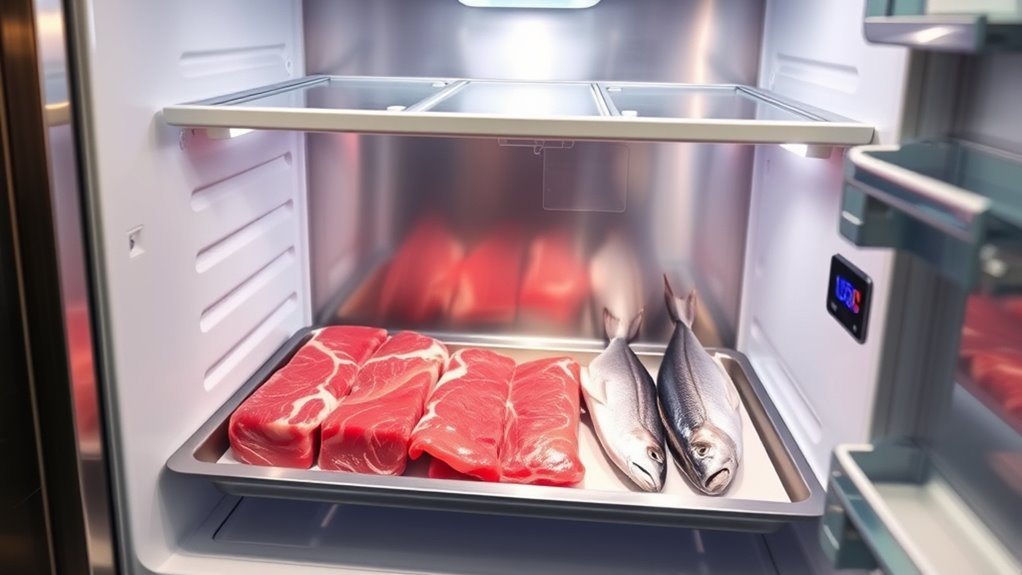
You should always store raw meats and seafood on the bottom shelf to prevent drips from contaminating other foods. Use leak-proof containers to contain any juices and keep your fridge clean. Keeping the temperature at or below 40°F guarantees these items stay safe and fresh. Additionally, maintaining proper temperature zones helps prevent cross-contamination and preserves food quality.
Store Raw Meats Properly
Storing raw meats and seafood on the bottom shelf of your refrigerator is essential for food safety. This prevents drips or leaks from contaminating other foods. Keep raw meats in their original packaging or place them in a leak-proof container to avoid cross-contamination, especially during meat marination or meat thawing. Here are some tips to guarantee proper storage:
- Always place raw meats on the lowest shelf to prevent juices from contaminating ready-to-eat foods.
- Use airtight, leak-proof containers when marinating meat to avoid leaks.
- Thaw meats in the fridge, never on the countertop, to keep temperatures safe and bacteria at bay.
- Be aware of food safety guidelines to ensure proper handling and storage of raw meats.
Use Leak-proof Containers
Using leak-proof containers is essential for preventing raw meats and seafood from spilling or dripping onto other foods in your refrigerator. Airtight packaging keeps juices contained, reducing the risk of cross-contamination. Choose containers with secure lids that prevent leaks and preserve freshness. Proper moisture control is also important; containers designed to regulate humidity help keep meats and seafood from drying out or becoming slimy. You can also find specialized containers that are specifically designed for storing raw proteins safely. By using these containers, you minimize messes and maintain a clean, safe fridge environment. This practice not only protects other perishable items but also makes cleaning easier. Always double-check that your containers are sealed tightly before storing raw meats or seafood on the bottom shelf. This simple step ensures you keep your fridge organized, hygienic, and safe for everyone.
Maintain Cold Temperatures
Maintaining a consistently cold temperature on the bottom shelf is essential for keeping raw meats and seafood safe. This prevents bacteria growth and cross-contamination. To guarantee proper temperature control, avoid overcrowding the shelf, which can impede airflow. Keep frozen foods in the freezer section, not the fridge, to prevent thawing. Use a fridge thermometer to monitor temperatures regularly. Proper beverage storage also helps maintain consistent coldness, ensuring drinks stay chilled without raising the fridge’s overall temperature. Additionally, choosing high-quality skincare products like Patchology can enhance your skincare routine, especially when dealing with skin concerns caused by environmental factors.
- Store raw meats and seafood on the bottom shelf to prevent drips onto other foods
- Keep the fridge between 35°F and 38°F (1.7°C-3.3°C) for safety
- Regularly check and adjust fridge settings to prevent temperature fluctuations
The Door Compartments: Ideal for Condiments and Beverages
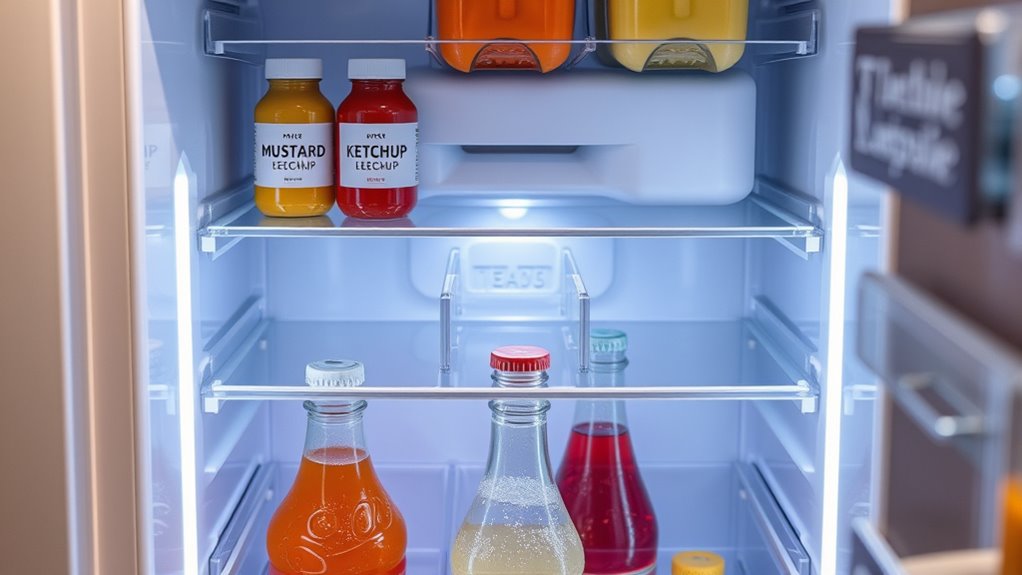
Because the door compartments of your fridge tend to experience more temperature fluctuations, they’re best suited for storing items like condiments and beverages that don’t require the coldest environment. Proper condiment organization guarantees easy access and prevents spills, while smart beverage placement keeps drinks readily available. Use the door shelves for sauces, dressings, and juice bottles, which are more tolerant of temperature shifts.
| Item Type | Ideal Storage Location | Notes |
|---|---|---|
| Condiments | Door compartments | Easy to find, accessible |
| Beverages | Door compartments | Quick grab for drinks |
| Dairy | Main fridge shelves | Maintain consistent coldness |
| Fresh produce | Crisper drawers | Keep fresh longer |
Temperature Variations and How They Affect Food Freshness
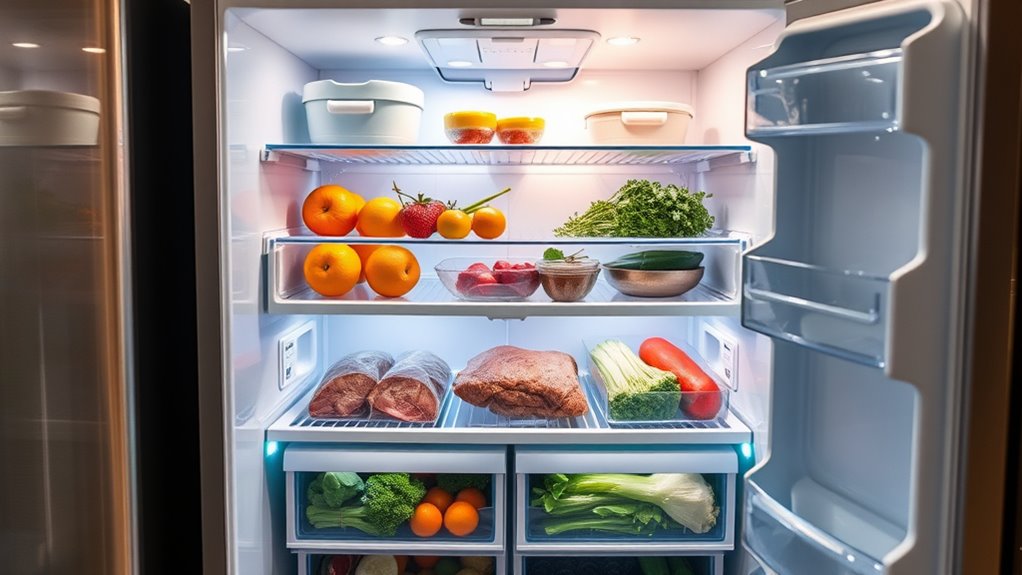
Temperature fluctuations within your fridge can considerably impact the freshness and safety of your food. Uneven temperature distribution can create warm spots, accelerating food spoilage and risking bacteria growth. To avoid this, monitor how temperature varies across different zones. Keep in mind:
- *Warm zones near the door* can cause perishables like dairy and meats to spoil faster.
- *Cold spots at the back or bottom* help preserve items longer by maintaining a consistent temperature.
- *Frequent door opening* introduces warm air, disrupting temperature stability and increasing spoilage risk.
Understanding these variations allows you to optimize storage placement, reducing food waste and ensuring freshness. Proper temperature distribution is key to preventing food spoilage and keeping everything safe and fresh longer.
Tips for Properly Organizing Your Fridge by Zone
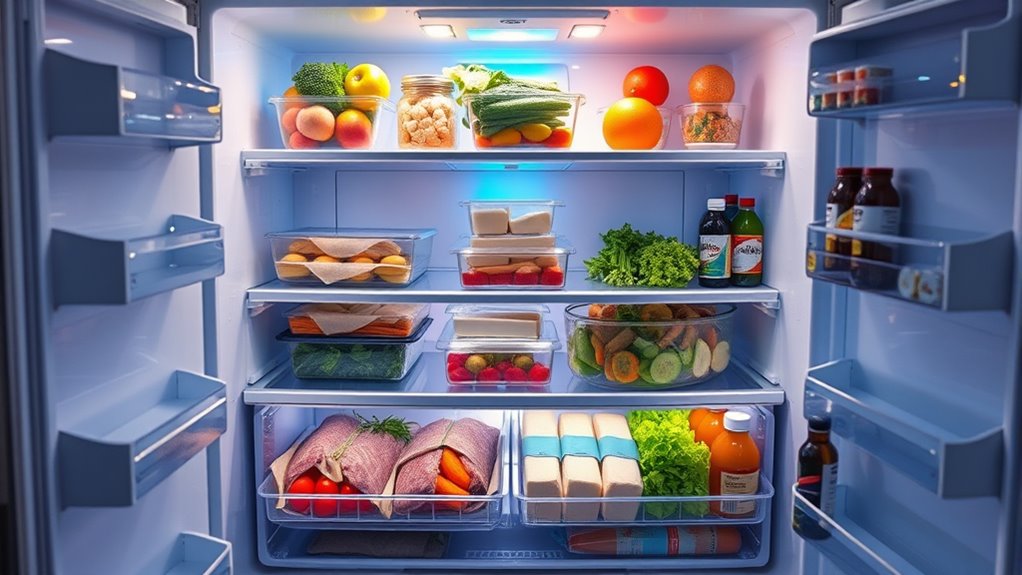
Organizing your fridge by zone helps keep food fresh longer and reduces waste. Proper placement improves air circulation, which maintains consistent temperatures and enhances energy efficiency. Store ready-to-eat foods and leftovers in the warmer top zone, while raw meats and seafood go on the bottom to prevent cross-contamination. Vegetables and fruits should be in dedicated drawers that promote humidity control. Use the middle shelves for dairy products and condiments. To optimize organization, consider this layout:
| Zone | Recommended Items |
|---|---|
| Top Shelf | Leftovers, drinks |
| Middle Shelves | Dairy, cooked foods |
| Bottom Shelf | Raw meats, seafood |
| Drawers | Fruits and vegetables |
| Door | Condiments, beverages |
Proper organization maximizes air flow, keeps items at consistent temperatures, and improves overall energy efficiency.
Common Mistakes That Compromise Food Safety and Freshness
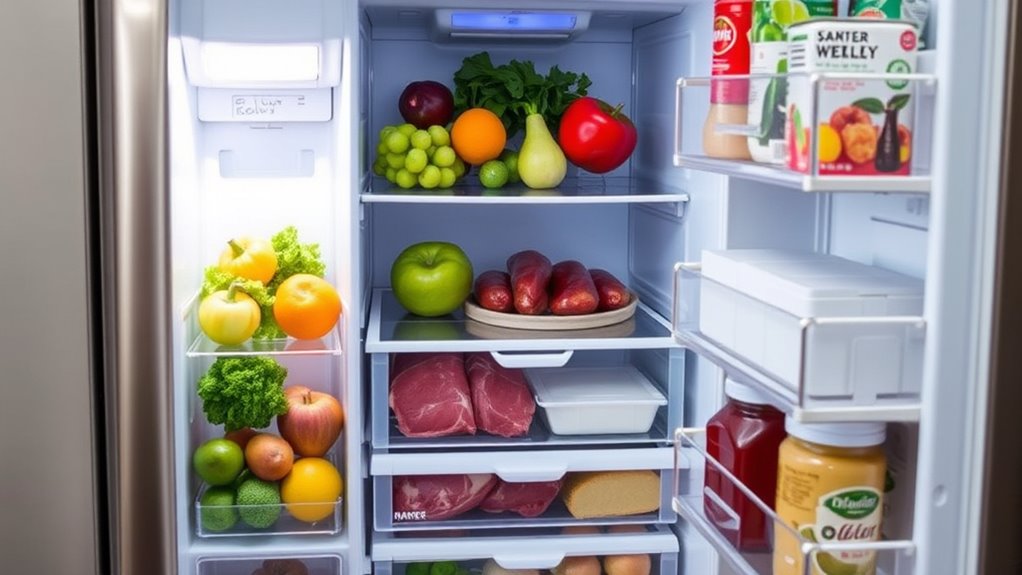
While organizing your fridge by zone improves food safety, mistakes in handling and storage can still put your freshness and health at risk. Common errors include storing perishable foods in the wrong areas, which accelerates food spoilage and increases the risk of contamination. Additionally, overcrowding the fridge hampers air circulation, leading to uneven temperatures and energy waste. Failing to check and set the correct temperature settings can also compromise food safety and reduce energy efficiency. Be mindful to:
- Keep raw meats on the bottom shelf to prevent drips and cross-contamination
- Avoid leaving leftovers out too long before refrigeration
- Set your fridge to the recommended temperature (around 37°F/3°C) to prevent spoilage and save energy
Avoiding these mistakes helps maintain food quality, safety, and energy efficiency.
Frequently Asked Questions
How Often Should I Calibrate My Fridge’s Temperature Settings?
You should calibrate your fridge’s temperature settings every six months to guarantee ideal cooling. During this process, adjust the thermostat if the temperature isn’t in the recommended range. Regular calibration frequency helps maintain proper food storage and prevents spoilage. Keep an eye on thermometer readings, and if you notice temperature inconsistencies, do a quick thermostat adjustment and recheck after a week. Consistent calibration keeps your fridge running efficiently.
Can Different Types of Refrigerators Have Varying Temperature Zones?
Think of your refrigerator as a chameleon—different types adapt their temperature zones for best performance. Yes, various refrigerator types like side-by-sides, top-freezers, and French doors have unique temperature zones. This means you can customize temperatures more precisely depending on your fridge’s design. Always check your model’s manual for specific temperature customization options, as each type may have different settings to optimize freshness and energy efficiency.
What Signs Indicate My Fridge’s Temperature Zones Are Malfunctioning?
If your fridge’s temperature zones are malfunctioning, you might notice inconsistent cooling, spoiled food, or ice buildup. Check the thermostat accuracy by using a thermometer to verify temperatures. Also, inspect the door seal integrity, ensuring it seals tightly; a compromised seal lets warm air in, disrupting temperature zones. These signs indicate your fridge needs attention to maintain proper cooling and prevent food spoilage.
Are There Specific Foods That Shouldn’T Be Stored in Certain Zones?
Yes, you should follow storage guidelines to guarantee food safety. Keep raw meats and seafood in the coldest zone, usually the bottom shelf, to prevent cross-contamination. Dairy products like milk and cheese should be stored in the middle or upper shelves, where temperatures are more stable. Fruits and vegetables do best in crisper drawers, but avoid storing ethylene-sensitive produce near ethylene-producing items. Proper storage helps maintain freshness and safety.
How Do External Factors Like Room Temperature Affect Fridge Zones?
Did you know that external room temperature can influence your fridge’s efficiency by up to 25%? When room temps rise, the fridge works harder, affecting air circulation and insulation quality. This can cause temperature fluctuations in different zones, risking spoilage. To keep your food safe, make sure your fridge is well-insulated and avoid placing it near heat sources. Proper placement helps maintain consistent temperatures regardless of outside fluctuations.
Conclusion
Knowing your fridge’s temperature zones can cut food waste by up to 20%. By organizing your fridge properly, you guarantee each item stays fresh longer and stays safe to eat. Remember, the top shelf is best for leftovers, while raw meats should go on the bottom to prevent cross-contamination. Take control of your fridge today—your food and your wallet will thank you!

